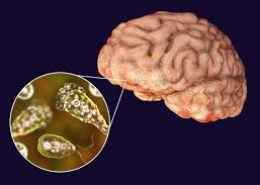The idea of a brain-eating amoeba is terrifying and often sensationalized, but it refers to a real organism known as Naegleria fowleri. This single-celled, free-living amoeba is found in warm freshwater environments such as lakes, rivers, and hot springs. Although infections are rare, they are often fatal. Understanding how Naegleria fowleri enters the body and causes such devastating effects is crucial for prevention and awareness.
Understanding Naegleria fowleri
Naegleria fowleri is a thermophilic (heat-loving) amoeba that thrives in warm water temperatures, typically between 25°C and 35°C (77°F and 95°F). It can be found in various aquatic environments, including freshwater lakes, rivers, hot springs, and poorly maintained swimming pools. It exists in three stages: cyst, trophozoite, and flagellate.
- Cyst Stage: In adverse conditions, such as low nutrients or temperatures, the amoeba forms a cyst, allowing it to survive until conditions improve.
- Trophozoite Stage: This is the active, feeding, and reproductive stage of the amoeba. It feeds on bacteria and organic matter in the water.
- Flagellate Stage: When conditions are suitable, the trophozoite transforms into a flagellate form, which allows it to move through water more efficiently.
The trophozoite stage is the infectious form that can cause primary amoebic meningoencephalitis (PAM) in humans.
Pathway to Infection
The most common route of infection occurs when contaminated water enters the nose. This can happen during activities like swimming, diving, or water sports in warm freshwater bodies. The amoeba attaches itself to the olfactory epithelium in the nasal passages and then migrates along the olfactory nerve to the brain. It is important to note that Naegleria fowleri cannot cause infection through drinking contaminated water, as it cannot survive in stomach acid and does not infect humans via ingestion.
The Mechanism of Brain Invasion
Once Naegleria fowleri reaches the brain, it begins to feed on brain tissue, causing severe inflammation and tissue damage. The exact mechanism by which the amoeba causes this damage is not entirely understood, but it involves the production of enzymes that degrade tissues and allow the amoeba to penetrate the brain. The amoeba’s feeding and replication within the brain lead to PAM, a disease characterized by rapid progression and high mortality.
Symptoms and Diagnosis
The symptoms of PAM typically appear within 1 to 9 days after exposure, and they often resemble those of bacterial meningitis, making early diagnosis challenging. Initial symptoms include headache, fever, nausea, vomiting, and stiff neck. As the disease progresses, symptoms may include confusion, seizures, hallucinations, and altered mental status. These symptoms result from the inflammation and destruction of brain tissue caused by the amoeba.
Diagnosis of PAM is difficult due to its rarity and non-specific early symptoms. It is typically confirmed through the identification of Naegleria fowleri in cerebrospinal fluid (CSF), brain tissue, or other body fluids. Molecular techniques such as polymerase chain reaction (PCR) and specific staining methods can also aid in detection.
Treatment and Prognosis
PAM is a medical emergency with a very high mortality rate, often exceeding 95%. Early diagnosis and treatment are critical, but even with prompt medical intervention, survival is rare. Treatment typically involves a combination of antimicrobial agents, such as amphotericin B, miltefosine, rifampin, and azithromycin. These drugs aim to kill the amoeba and manage the symptoms of the infection. Supportive care in an intensive care unit (ICU) is often necessary to manage brain swelling and other complications.
Prevention Strategies
Given the rarity of PAM but its severe consequences, prevention is crucial. Some strategies to reduce the risk of infection include:
- Avoiding Freshwater Activities in Warm Weather: The amoeba thrives in warm water, so avoiding activities like swimming or diving in freshwater lakes, rivers, and hot springs during hot weather can reduce the risk.
- Using Nasal Clips or Holding the Nose Shut: When engaging in activities that may force water up the nose, such as diving or jumping into water, using nose clips or holding the nose shut can help prevent water from entering the nasal passages.
- Avoiding Stirring Up Sediment: The amoeba is often found in the sediment at the bottom of warm freshwater bodies. Avoiding activities that disturb sediment can reduce the risk of exposure.
- Chlorinating Pools and Other Recreational Water Sources: Proper chlorination and maintenance of swimming pools and hot tubs can kill Naegleria fowleri and other pathogens.
- Using Safe Water for Nasal Irrigation: For nasal irrigation or sinus rinsing, such as with a neti pot, always use distilled or sterilized water. Tap water should be boiled and then cooled before use.
Conclusion
Naegleria fowleri is a rare but deadly organism that can enter the human body through the nose during water-related activities in warm freshwater environments. While infections are extremely rare, they are often fatal, highlighting the importance of awareness and prevention. By understanding the pathways of infection and taking appropriate precautions, the risk of contracting this deadly amoeba can be minimized. Despite the rarity of PAM, ongoing research and public health efforts are crucial to further understanding and preventing this devastating disease.

